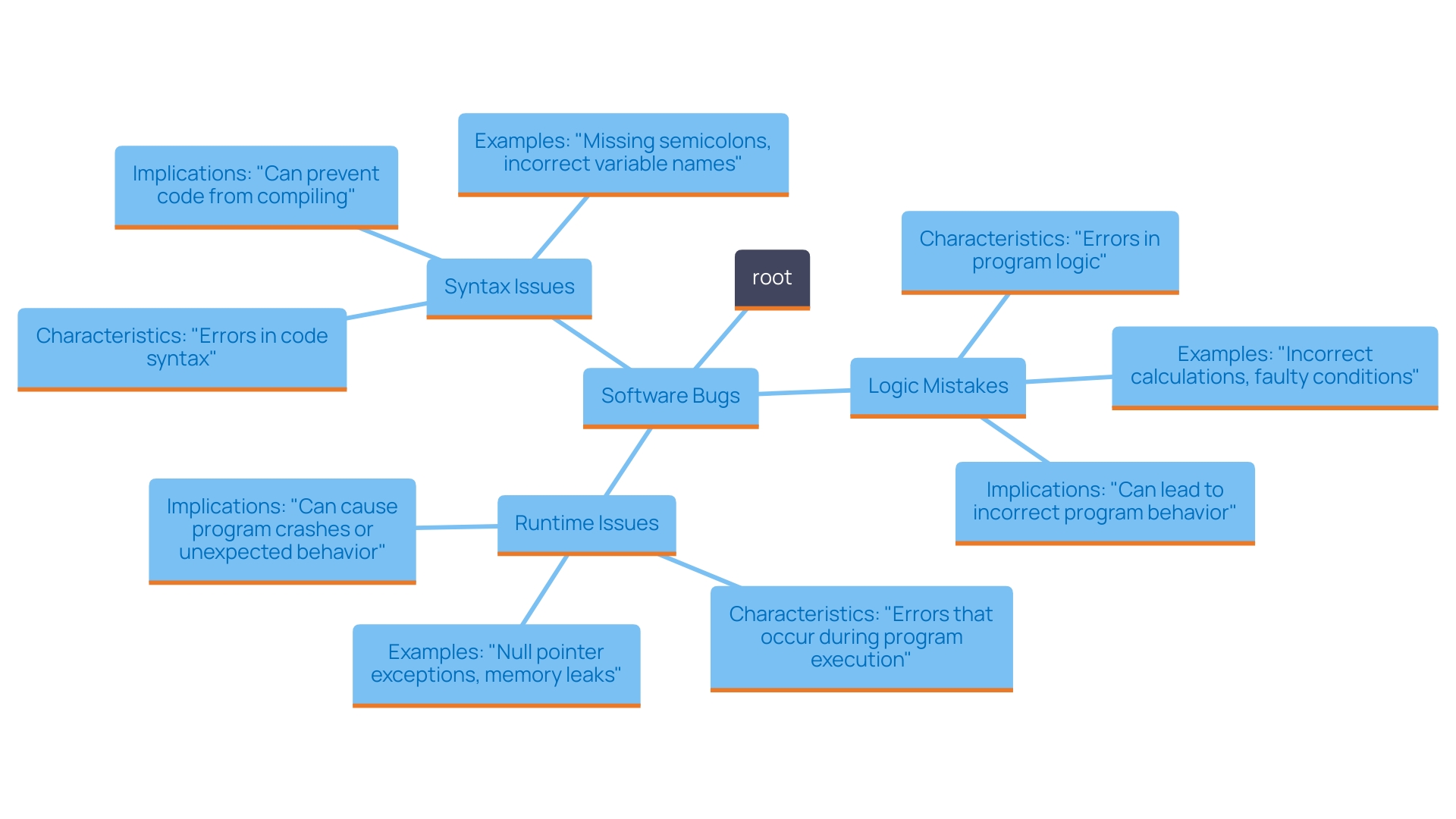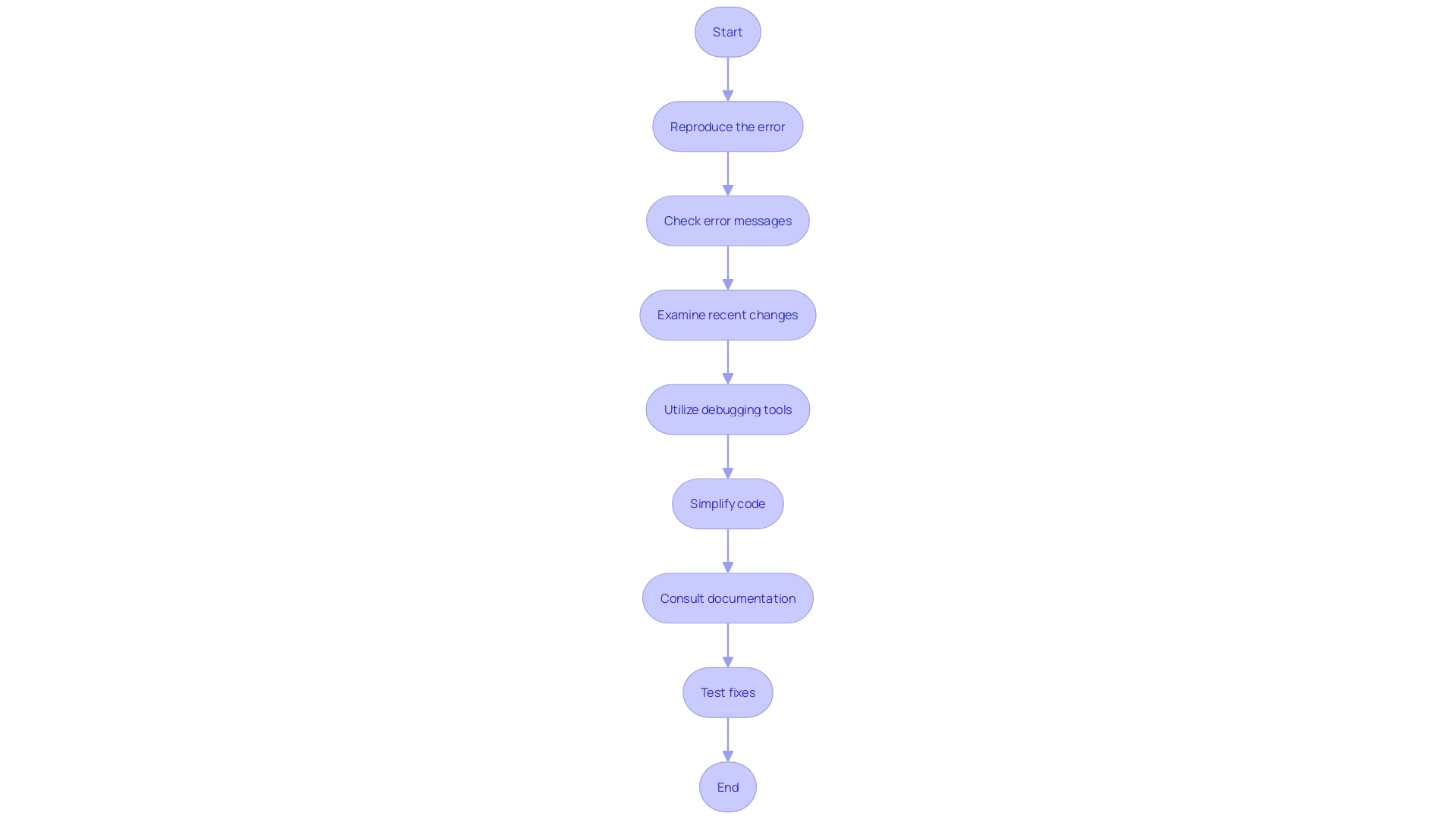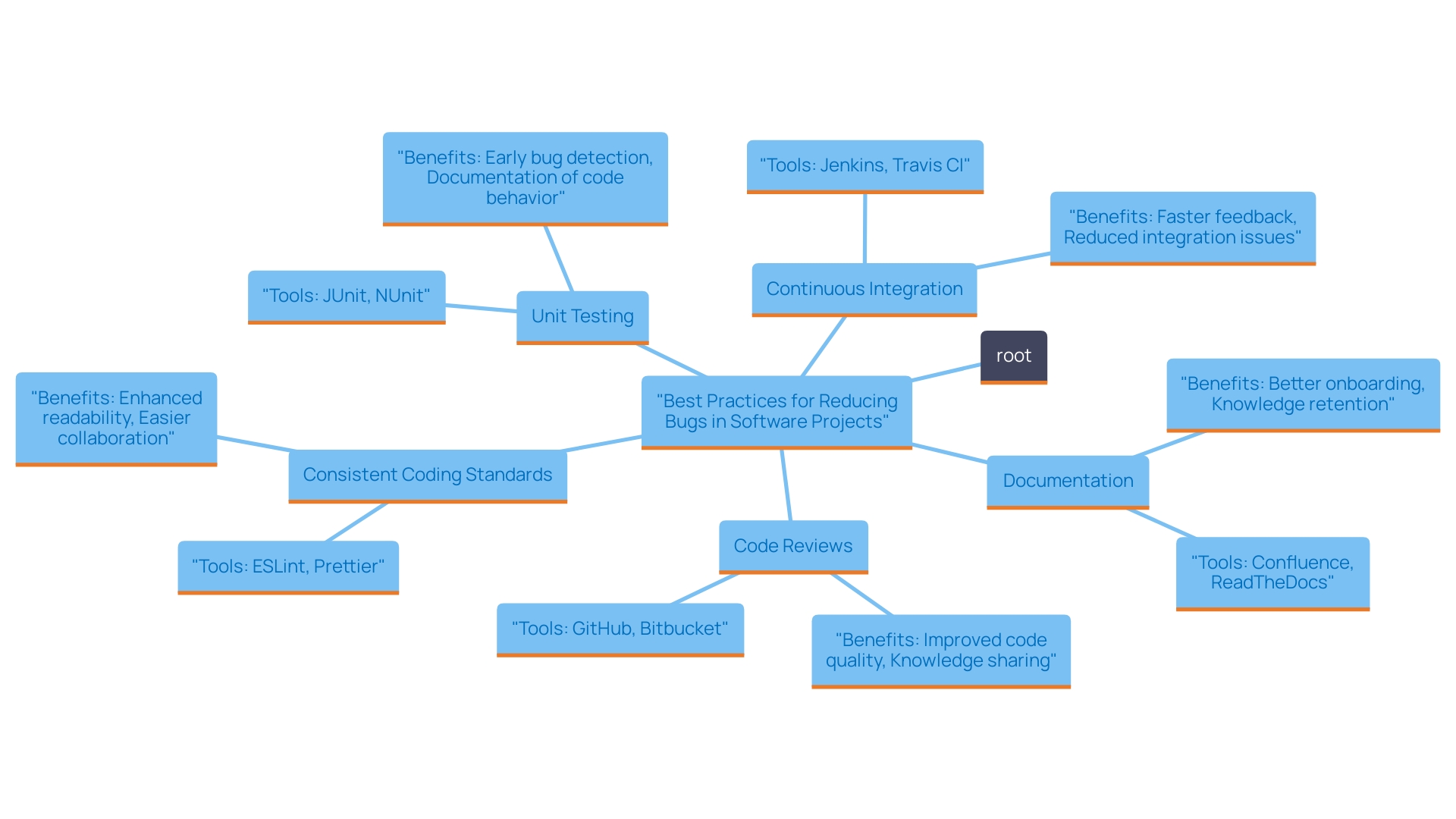Introduction
In the dynamic landscape of software development, the presence of bugs can significantly hinder progress and impact user satisfaction. Understanding the various types of software bugs—ranging from syntax and logic errors to runtime issues—is crucial for developers aiming to maintain high-quality standards. With the right strategies and tools, such as Kodezi, teams can not only identify and resolve these bugs more efficiently but also implement best practices that prevent future occurrences.
This article delves into the common issues faced by developers, outlines a systematic approach to troubleshooting, and highlights effective tools for bug tracking and resolution, ultimately paving the way for enhanced productivity and software reliability.
Understanding Software Bugs: Common Issues and Their Causes
Software bugs manifest in various forms, and understanding their classifications is essential for effective debugging and maintaining software integrity. The primary categories include:
-
Syntax Issues: These issues arise from mistakes in the code that prevent it from compiling or executing. Common culprits include typographical mistakes or improper use of the programming language's syntax. Syntax issues can be particularly troublesome, as they can halt development processes, underscoring the need for meticulous coding practices. Automated code debugging tools like Kodezi can instantly identify and correct these issues, significantly reducing the time developers spend on syntax mistakes. Recent statistics from 2024 reveal that approximately 30% of developers attribute project delays to syntax issues, highlighting the critical importance of addressing these matters promptly.
-
Logic Mistakes: Unlike syntax issues, logic mistakes permit the software to operate but produce incorrect results. These bugs often stem from flawed algorithms or incorrect assumptions in the code logic. They can be insidious, surfacing only under specific conditions and leading to unexpected behavior. Comprehending these mistakes is essential, particularly as numerous contemporary debugging methods emphasize recognizing and correcting logical flaws. Kodezi's AI-driven automated testing improves this process, ensuring that logic flaws are detected early, which can greatly decrease debugging time and boost overall productivity.
-
Runtime Issues: These issues arise during the execution of a program and can result from invalid operations, such as division by zero or attempting to access null references. Runtime issues can severely impact user experience, making it imperative for developers to implement robust handling and testing procedures. With the platform's automated builds and testing procedures, developers can identify these issues before they worsen, ensuring a smoother user experience. In 2024, data shows that runtime errors account for nearly 25% of user-reported issues, underscoring the necessity of thorough testing protocols.
The importance of regression testing is emphasized by experts like Sunitha Paloju, who asserts, 'Regression testing should be performed whenever new code changes are introduced.' Backed by automated testing features, this process guarantees that current functionalities stay intact while avoiding the introduction of new issues. As QA teams document and track issues, assigning severity levels to prioritize fixes, they can effectively manage the impacts of these common software flaws, ultimately enhancing productivity and software reliability.

A Step-by-Step Approach to Troubleshooting Software Bugs
To effectively troubleshoot software bugs and enhance productivity using Kodezi, follow these streamlined steps:
-
Reproduce the Bug: Begin by identifying the specific conditions that trigger the bug. Consistently reproducing the issue is crucial for understanding its root causes and behavior.
-
Check Error Messages: Pay close attention to any error messages generated by the software. These messages often contain valuable clues regarding the nature of the bug and can guide your troubleshooting process.
-
Examine Recent Changes: If the software was functioning correctly before, investigate any recent code modifications or updates, as these could be responsible for introducing new issues.
-
Use Debugging Tools: Utilize advanced debugging tools that provide features such as automatic code correction and bug analysis. This allows for precise identification of logic failures and incorrect values, significantly boosting efficiency. Recent advancements in debugging tools have made this process easier than ever.
-
Simplify the Code: In cases where the bug is complex, isolate the problematic code by simplifying it. Commenting out or removing certain sections can help narrow down the source of the issue more effectively.
-
Consult Documentation: Reference the documentation and FAQs relevant to the programming language or framework in use. This resource often highlights common pitfalls and best practices that can resolve the issue more quickly. Getting to know the bot's capabilities will improve your interaction with it.
-
Test Fixes Thoroughly: After identifying a potential fix, implement it and conduct extensive testing under various conditions to confirm that the bug is resolved and no new issues arise.
By leveraging tools like Kodezi, developers can streamline their bug-fixing processes. This efficiency in troubleshooting not only saves time but also enhances overall software quality. Furthermore, industry experts emphasize the importance of a methodical approach to replicating issues, asserting that a clear understanding of the issue's context is essential for effective resolution. Case studies illustrate the success of establishing easy-to-maintain regression tests using modern debugging methodologies.

Implementing Best Practices for Future Bug Prevention
To minimize the likelihood of bugs in future software projects, implementing the following best practices is essential:
-
Code Reviews: Conducting regular peer code reviews is crucial for early issue detection. Fresh eyes on the code can uncover potential problems that the original author may have missed, significantly improving software quality. Research indicates that groups participating in regular code evaluations can decrease errors by as much as 30%. Tools such as Kodezi CLI enhance this process by autonomously improving your codebase and resolving issues before they reach production.
-
Unit Testing: Establish unit tests to verify that each component functions correctly. This proactive approach assists in identifying problems during the development cycle, decreasing the cost and effort involved in resolving issues later. Effective unit testing can prevent up to 70% of bugs from being deployed. The extension supports this by automating testing processes, significantly enhancing overall efficiency.
-
Consistent Coding Standards: Adhering to consistent coding standards enhances the readability and maintainability of the code. This practice facilitates better collaboration among developers, ensuring everyone can easily understand and contribute to the codebase. Industry specialists emphasize that uniform coding standards enhance group efficiency, a principle that the platform reinforces through its user-friendly documentation features.
-
Continuous Integration: Leverage continuous integration (CI) tools to automate testing and integration processes. Frequent code changes allow for prompt issue detection, maintaining high software quality throughout development. CI practices can enhance project delivery speed by as much as 50%. The CLI facilitates this by allowing groups to swiftly AutoHeal codebases, conserving valuable time on pull requests.
-
Documentation: Maintaining clear and comprehensive documentation is vital. Documentation should encompass detailed explanations of algorithms, functions, and classes, providing developers with necessary references during troubleshooting. The Extension offers types of documentation such as Line-By-Line Commenting, Code Summary, and Docstring, ensuring thoroughness. Recent best practices for 2024 emphasize that thorough documentation fosters better group communication and helps prevent misunderstandings that could lead to bugs.
By adopting these practices and using tools such as CLI and the Extension for Visual Studio Code, groups can significantly improve their bug management strategies, resulting in more efficient and productive development cycles. The incorporation of Kodezi's features into these practices not only streamlines workflows but also enables groups to achieve their efficiency goals.

Leveraging Tools for Efficient Bug Tracking and Resolution
Utilizing tracking tools is essential for streamlining the identification, management, and resolution of software issues. Here’s a look at some of the most effective options currently available:
-
JIRA: This robust project management tool is favored by many developers for its capability to track issues, prioritize bugs, and monitor progress seamlessly. The latest bug fix release for JIRA Software, version 8.5.19, exemplifies its commitment to continuous improvement. Notably, JIRA's recent enhancements, including built-in SAML 2.0 support for secure single sign-on (SSO), significantly improve user access management, enhancing both security and user convenience. Recent studies indicate that groups utilizing JIRA report a 30% rise in productivity due to its comprehensive tracking features.
-
Bugzilla: An established open-source solution, Bugzilla excels in assisting groups in managing software defects efficiently. Its straightforward interface is particularly advantageous for developers seeking a user-friendly experience without unnecessary complexity. Bugzilla’s usage statistics indicate that it is preferred by 25% of open-source projects, demonstrating its effectiveness in various environments.
-
Trello: Recognized for its adaptability, Trello can be tailored to monitor issues and manage tasks across different resolution stages. This versatility makes it a popular option for groups looking to adjust their workflow to specific project needs. However, while Trello is highly adaptable, it may lack some advanced bug tracking features found in more specialized tools like JIRA and Bugzilla.
-
Sentry: As a real-time issue tracking tool, Sentry monitors applications for bugs and generates detailed reports. This functionality allows developers to understand and rectify issues swiftly, minimizing downtime and enhancing overall productivity. Sentry has been demonstrated to cut the time to resolution by 40%, establishing it as a top option for groups requiring immediate feedback on errors.
-
GitHub Issues: For groups utilizing GitHub for version control, the Issues feature is a powerful asset. It enables direct tracking of bugs within the code repository, linking discussions to specific code changes, which fosters better collaboration and transparency. GitHub Issues is particularly effective for development groups already integrated into the GitHub ecosystem, as it streamlines the bug-reporting process.
These tools not only facilitate effective bug management but also contribute to enhanced security and user convenience. By understanding the strengths and weaknesses of each tool, teams can choose the best solution to meet their specific needs, ultimately leading to greater efficiency and productivity in software development.
![]()
Conclusion
In the ever-evolving world of software development, effectively managing bugs is essential for maintaining high-quality standards and ensuring user satisfaction. By understanding the various types of software bugs—such as syntax errors, logic errors, and runtime errors—developers can adopt a proactive approach to troubleshooting. Utilizing tools like Kodezi enhances this process, enabling teams to identify and resolve issues more efficiently, significantly reducing downtime and boosting productivity.
Implementing systematic troubleshooting steps, such as reproducing bugs, checking error messages, and leveraging advanced debugging tools, further empowers developers to tackle challenges head-on. Coupled with best practices like regular code reviews, unit testing, and maintaining consistent coding standards, teams can minimize the risk of future bugs and streamline their development processes. The integration of tools like Kodezi CLI and the Kodezi Extension not only aids in efficient bug management but also fosters a culture of collaboration and continuous improvement.
Ultimately, leveraging effective bug tracking tools and methodologies transforms the way software development teams operate. By prioritizing bug resolution and prevention, organizations can enhance their productivity and deliver reliable software solutions that meet user expectations. Embracing these strategies paves the way for a more efficient, error-free development cycle that drives innovation and success in the competitive tech landscape.
Frequently Asked Questions
What are the main classifications of software bugs?
The primary classifications of software bugs include Syntax Issues, Logic Mistakes, and Runtime Issues. Syntax Issues arise from mistakes in the code that prevent it from compiling or executing. Logic Mistakes allow the software to operate but produce incorrect results due to flawed algorithms or incorrect assumptions. Runtime Issues occur during program execution, often resulting from invalid operations.
What are Syntax Issues and why are they significant?
Syntax Issues are mistakes in the code that prevent it from compiling or executing, often caused by typographical errors or improper syntax usage. They are significant because they can halt development processes, leading to project delays, with around 30% of developers attributing such delays to these issues.
How do Logic Mistakes differ from Syntax Issues?
Logic Mistakes permit the software to run but produce incorrect results, stemming from flawed algorithms or incorrect assumptions in the code logic. They can be more insidious, surfacing only under specific conditions, unlike Syntax Issues which prevent execution entirely.
What are Runtime Issues and their impact on user experience?
Runtime Issues occur during the execution of a program due to invalid operations, such as division by zero or accessing null references. These issues can severely impact user experience, making it essential for developers to implement robust handling and testing procedures.
Why is regression testing important in software development?
Regression testing is crucial because it ensures that current functionalities remain intact after new code changes are introduced. It helps avoid the introduction of new issues, thereby enhancing software reliability and productivity.
What steps should developers follow to troubleshoot software bugs effectively?
Developers should follow these steps: 1. Reproduce the Bug 2. Check Error Messages 3. Examine Recent Changes 4. Use Debugging Tools 5. Simplify the Code 6. Consult Documentation 7. Test Fixes Thoroughly
How can Code Reviews help in minimizing bugs?
Conducting regular peer code reviews is essential for early issue detection, as fresh eyes can uncover potential problems that the original author may have missed. This practice can significantly improve software quality and decrease errors by up to 30%.
What role does Unit Testing play in bug prevention?
Unit Testing helps verify that each component functions correctly, allowing for the identification of problems during the development cycle. Effective unit testing can prevent up to 70% of bugs from being deployed.
How does Continuous Integration contribute to software quality?
Continuous Integration automates testing and integration processes, enabling prompt issue detection with frequent code changes. This practice can enhance project delivery speed by as much as 50%.
What are some effective tracking tools for managing software bugs?
Effective tracking tools include JIRA, Bugzilla, Trello, Sentry, and GitHub Issues. Each tool has its strengths, such as JIRA's comprehensive tracking features, Bugzilla's user-friendly interface, and Sentry's real-time issue monitoring capabilities.




